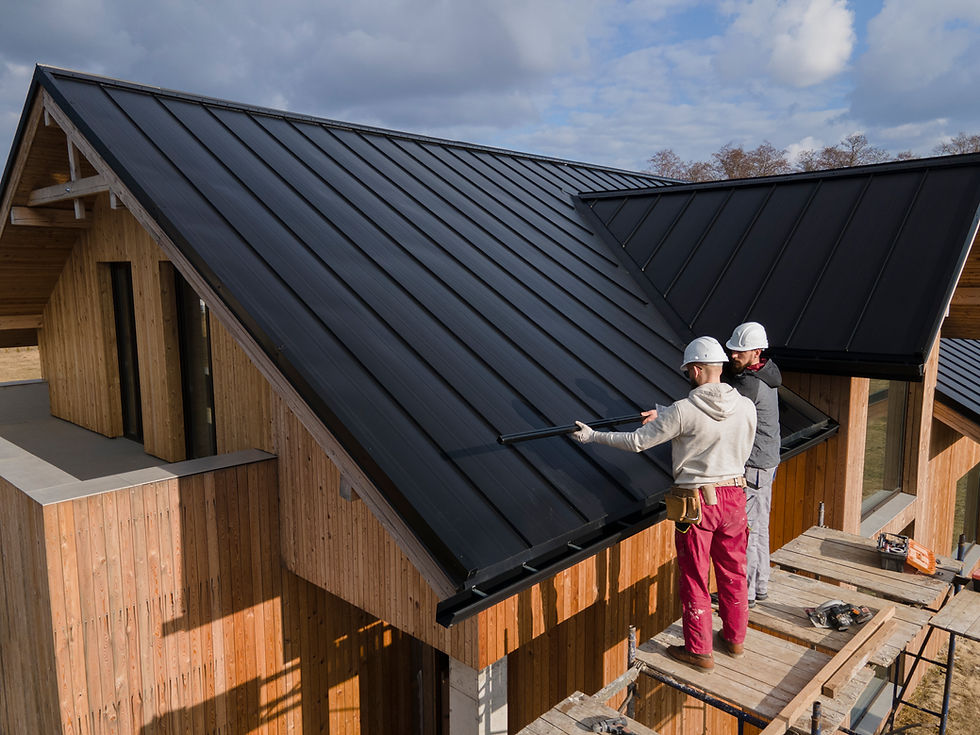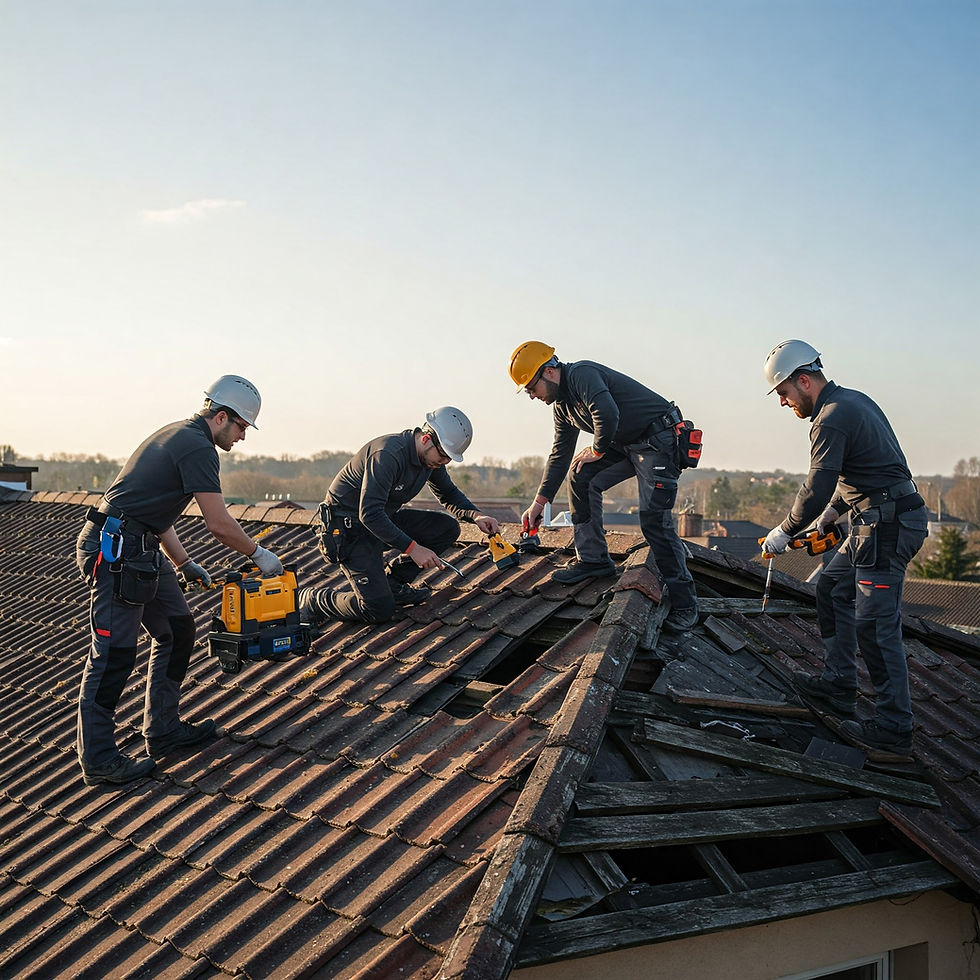Winter Roof Repair Tips: Prevent Ice Dams and Costly Leaks
- Adam Smith
- Jul 1
- 4 min read
Winter can be charming, with snow-covered roofs and icy landscapes. However, for homeowners, it often comes with hidden dangers—ice dams, roof leaks, and structural damage. A poorly maintained roof in winter can lead to expensive roof repairs, not to mention the risk to your home's interior.
By addressing roofing issues early, you can protect your home, your investment, and your peace of mind. Whether you have flat roofing or pitched roofing, knowing the right steps to take during the winter season is essential.
Understanding Ice Dams and Their Effects
Ice dams are thick ridges of frozen water that form at the edge of your roof. They stop melting snow from draining properly, causing water to back up under your shingles. Once water enters your home, it can damage insulation, ceilings, walls, and even electrical wiring.
But why do ice dams form?
They result from poor insulation, inadequate ventilation, or fluctuating roof temperatures. Heat from your attic melts snow on the roof. The water runs down, refreezes near the colder eaves, and creates a dam that holds more water. Without proper action, this can lead to serious water intrusion and the need for emergency roof repairs.
1. Inspect Your Roof Before Winter
Before winter hits, examine your roof for damaged shingles, flashing, or sealant cracks. Identifying these issues early helps prevent leaks when snow and ice begin to accumulate.
Check for:
Loose or missing shingles
Gaps around chimneys or skylights
Blocked or damaged gutters
Hiring a local roofer for a professional inspection ensures no detail is missed. These experts can identify even the smallest vulnerabilities that might turn into bigger problems during freezing temperatures.

2. Ensure Proper Insulation and Ventilation
A well-insulated attic helps maintain a consistent temperature across your roof, preventing uneven melting. Good ventilation is just as crucial; it allows warm air to escape while drawing in cool air from outside.
Key steps include:
Adding insulation to attic floors
Sealing air leaks in the attic
Installing roof or soffit vents
Whether you have pitched roofing or flat roofing, ventilation plays a vital role in maintaining roof health throughout winter.
3. Clean Your Gutters Regularly
Clogged gutters stop water from draining off the roof properly. During winter, this can worsen ice dam formation. Leaves, twigs, and debris in gutters can freeze, creating a solid block of ice. This traps melting snow on your roof, leading to leaks and potential structural damage.
Make it a habit to:
Clean gutters before the first snowfall
Check downspouts for obstructions
Use gutter guards to reduce future clogs
Even a small investment in cleaning tools or hiring roofing services for seasonal maintenance can save thousands in roof repairs.
4. Remove Snow Buildup Quickly and Safely
Allowing snow to sit on your roof for days is dangerous. The weight adds stress to your roof structure, and the thaw-freeze cycle can create major water intrusion.
Use a roof rake with a telescopic handle to safely remove snow from the ground. Avoid climbing on icy roofs, especially if you lack experience. For large or hard-to-reach areas, contact a roofing contractor to manage snow removal professionally.
5. Repair Flashing and Seals Around Openings
Flashing is the metal barrier around chimneys, vents, and skylights that prevents water from entering. Over time, flashing may loosen or corrode. In winter, even a small gap can lead to massive water damage once snow begins melting.
Replace worn flashing and apply waterproof sealants around all openings. It's best to do this in dry, above-freezing conditions before snow starts to fall.
6. Schedule Preventive Roof Repairs Early
Don’t wait for a leak to act. Schedule roof repairs at the first sign of trouble. Small fixes—like replacing damaged tiles or sealing cracks—can prevent more serious problems.
If your roof has already been repaired multiple times, it might be time to consider a roof replacement. Winter isn't ideal for full replacements, but you can still start planning and booking assessments early with a trusted roofing contractor.
7. Know the Signs of a Winter Roof Leak
Leaks in winter aren’t always obvious. Water doesn’t drip immediately—it can seep slowly through insulation and walls, causing silent damage.
Common warning signs include:
Water stains on ceilings or walls
Musty odours in the attic
Peeling paint near the roofline
Ice forming on interior walls
If you notice any of these symptoms, act fast. A local roofer can assess the situation and provide urgent roofing services to stop the damage.
8. Avoid DIY Repairs in Harsh Conditions
Winter conditions are dangerous for roof work. Slippery surfaces and freezing temperatures make DIY efforts risky. You may also void warranties or cause unintentional damage.
Always hire a licensed roofing contractor for winter roof jobs. They have the proper gear, safety training, and materials suited for cold-weather repairs.
9. Check for Ice Dams After Heavy Snowfall
After every significant snowfall, take time to look for ice dams. Watch for icicles hanging from the roof edge or water dripping from unusual places. These could be early signs of dam formation.
If an ice dam is present:
Use calcium chloride ice melt (never rock salt)
Place it in a sock and lay it vertically on the ice dam
Never chip away ice with tools, which may damage the shingles
Alternatively, call a roofing services provider experienced in winter solutions to safely remove dams.
10. Plan for Long-Term Roofing Solutions
Winter roof maintenance shouldn't just be reactive. Think long-term. Investing in the right materials and designs can prevent recurring problems.
Consider:
Metal roofing for better snow shedding
Heated cables to prevent ice buildup
Improved drainage systems for flat roofing
High-quality underlayment for pitched roofing
Over time, proactive upgrades reduce the need for constant roof repairs and save on energy bills.
Conclusion
Winter presents many challenges, but your roof doesn’t have to be one of them. By preparing in advance and acting quickly, you can avoid ice dams, water leaks, and costly repairs. Proper insulation, timely inspections, and snow management go a long way in protecting your home during the colder months.
Don’t overlook the importance of professional support—working with an experienced roofing contractor ensures all issues are handled safely and effectively. Whether it's regular maintenance or emergency roof repairs, the right help makes all the difference.



Comments